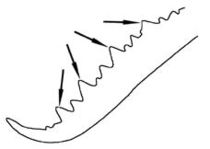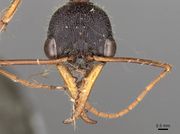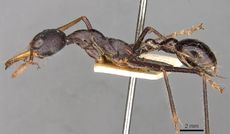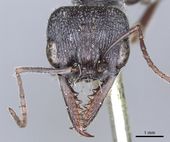Key to Myrmecia of the southwestern Australian Botanical Province
This worker key is based on: Heterick, B. E. 2009a. A guide to the ants of South-western Australia. Records of the Western Australian Museum, Supplement 76: 1-206. Part 2.
This key adapted from Ogata and Taylor (1991): readers are also referred to illustrations in that key. Note: The workerless parasite Myrmecia inquilina Douglas and Brown is not included in this key, which treats workers only.
You may also be interested in
1
- Occipital carina present (indicated by broken lines) (Figure 441) . . . . . 2
- Occipital carina lacking (curvature of occiput indicated by dotted lines) (Figure 442) . . . . . 19
2
return to couplet #1
- Subapical portion of mandible with a supplementary ventral tooth (Figure 443) . . . . . 3
- Subapical portion of mandible without a supplementary ventral tooth (Figure 444) . . . . . 17
3
return to couplet #2
- Mandibles each with 3 enlarged teeth apart from the apical tooth (Figure 445) . . . . . Myrmecia forceps
- Mandibles each with 4 or more enlarged teeth apart from the apical tooth (Figure 446) . . . . . 4
4
return to couplet #3
- Mandibles medium reddish-brown to dark brown, approximately concolorous with head capsule . . . . . 5
- Mandibles light yellowish- to reddish-brown, distinctly lighter in colour than head capsule . . . . . 6
5
return to couplet #4
- Apex of gaster reddish to yellowish . . . . . Myrmecia regularis
- Apex of gaster dark brown to blackish-brown . . . . . Myrmecia erecta
6
return to couplet #4
- Apex of gaster yellowish; scapes darker than head . . . . . 7
- Apex of gaster blackish; scapes concolorous with, or lighter than head . . . . . 8
7
return to couplet #6
- Basal portion of gaster dark blackish-brown . . . . . Myrmecia analis
- Basal portion of gaster reddish-brown . . . . . Myrmecia nigriscapa
8
return to couplet #6
- Mandibular shaft generally even in width, not narrowed basally (Figure 447) . . . . . 9
- Mandibular shaft narrow at extreme base, broadened over basal quarter to fifth of its length (Figure 448) . . . . . 11
9
return to couplet #8
- Petiolar peduncle short, at most as long as node, and not reaching the apices of the hind coxae when they are extended posteriad (Figure 449) . . . . . Myrmecia picticeps
- Petiolar peduncle longer than petiolar node; reaching or exceeding the apices of the hind coxae when they are extended posteriad (Figure 450) . . . . . 10
10
return to couplet #9
- Pronotum with erect setae shorter than those of first funicular segment . . . . . Myrmecia rubripes
- Pronotum with erect setae longer than those of first funicular segment . . . . . Myrmecia arnoldi
11
return to couplet #8
- Clypeus dark brown, concolorous with head. . . . . Myrmecia pavida
- Clypeus yellowish, concolorous with mandibles . . . . . 12
12
return to couplet #11
- Setae on head and mesosoma long and thick, those on sides near posterior corners of head extending beyond outer margins of eyes . . . . . Myrmecia fulgida
- Setae on head and mesosoma short and thin, those on sides near posterior corners of head not extending beyond outer margins of eyes . . . . . 13
13
return to couplet #12
- Head blackish, concolorous with gaster; mesosoma and nodes pale yellow, concolorous with mandibles . . . . . 14
- Head dark reddish-brown to yellowish-brown, lighter than gaster; mesosoma and nodes light reddish-brown to dark brown, darker than mandibles . . . . . 15
14
return to couplet #13
- Legs blackish-brown, much darker than mesosoma . . . . . Myrmecia fuscipes
- Legs yellowish, concolorous with mesosoma . . . . . Myrmecia desertorum
15
return to couplet #13
- Scape with numerous erect or suberect setae (Note: this character may be hard to see on abraded specimens) . . . . . Myrmecia nigriceps
- Scape almost lacking erect or suberect setae . . . . . 16
16
return to couplet #15
- Mesosoma light reddish-brown; head concolorous with mesosoma; petiolar spiracle usually situated somewhat dorsally on peduncle . . . . . Myrmecia gratiosa
- Mesosoma yellowish-brown to dark brown; petiolar spiracle usually situated laterally on Peduncle . . . . . Myrmecia vindex
17
return to couplet #2
- Coxae orange; femora predominantly orange tending to brown near attachment of tibiae . . . . . Myrmecia urens complex sp. JDM 728 (there are two named species from this group previously reported from the SWBP: Myrmecia nigra and Myrmecia infima but they cannot be assigned to this or the other two species from this species group [see couplet 18 just below], see discussion under the identification section of either of these species for other details)
- Coxae dark brown; femora predominantly dark brown tending to orange near attachment of tibiae . . . . . 18
18
return to couplet #17
- Viewed dorsally, mesosoma and node rugose and punctate (Figure 451); length of ocular setae usually < diameter of one facet . . . . . Myrmecia urens complex sp. JDM 1
- Viewed dorsally, mesosoma and node with reduced sculpture (node may be virtually smooth and shining) (Figure 452); length of ocular setae > width of one facet . . . . . Myrmecia urens complex sp. JDM 71
19
return to couplet #1
- Posterior tibial spur of hind leg a simple spine-like process (Figure 453) . . . . . Myrmecia callima
- Posterior tibial spur of hind leg distinctly pectinate (Figure 454) . . . . . 20
20
return to couplet #19
- Subapical portion of mandible with a single row of teeth (Figure 443); head bicoloured with anterior section yellow, posterior section brown to black . . . . . Myrmecia picta
- Subapical portion of mandible with a supplementary ventral tooth (Figure 444); head uniformly coloured . . . . . 21
21
return to couplet #20
- Dentition strongly developed along entire inner margin of mandible (Figure 455) . . . . . 22
- Dentition reduced or vestigial in the sub-basal portion of mandible (Figure 456) . . . . . 30
22
return to couplet #21
- Clypeal setae long, reaching at least to the basal quarter of mandibles (Figure 457) . . . . . 23
- Clypeal setae short, at most only slightly exceeding anterior clypeal margin (Figure 458) . . . . . 25
23
return to couplet #22
- Postpetiole distinctly sculptured (Figure 459); pubescence on gaster yellow . . . . . Myrmecia rugosa
- Postpetiole with at most vestigial sculpture (Figure 460); in doubtful cases, pubescence on gaster bright orange . . . . . 24
24
return to couplet #23
- Standing setae on pronotum mostly longer than first funicular segment; clypeus without yellow pubescence; mandible of more-or-less the same width throughout its length; (bright orange pubescence on gaster distinctive) . . . . . Myrmecia michaelseni
- Standing setae on pronotum mostly shorter than first funicular segment; clypeus may have yellowish pubescence; mandible noticeably tapered along its length (gastral pubescence off white to yellowish in specimens seen) . . . . . Myrmecia varians
25
return to couplet #22
- Erect setae on hind tibia abundant and long, some as long or longer than maximum width of tibia (Figure 461) . . . . . 26
- Erect setae on hind tibia sparse and short, shorter than maximum width of tibia (Figure 462) . . . . . 27
26
return to couplet #25
- Mandibles yellowish, lighter than head . . . . . Myrmecia chasei
- Mandibles dark brown, concolorous with head . . . . . Myrmecia ludlowi
27
return to couplet #25
- Mesosoma essentially uniformly black; petiole black . . . . . Myrmecia sp. near Myrmecia pilosula
- Mesosoma more-or-less uniformly light reddish to yellowish or bicoloured black-and-red; petiole yellowish to reddish brown . . . . . 28
28
return to couplet #27
- With combination of mandibles dark brown, concolorous with head, and pubescence on clypeus whitish . . . . . Myrmecia dispar
- Either mandibles lighter in colour, or pubescence on clypeus yellowish . . . . . 29
29
return to couplet #28
- Pubescence of clypeus yellowish; scape not exceeding posterior border of head (and see Species Description) . . . . . Myrmecia elegans
- Pubescence of clypeus whitish; scape exceeding posterior border of head by about half the length of first funicular segment (and see Species Description) . . . . . Myrmecia occidentalis
30
return to couplet #21
- Clypeus with distinctly long, forwardly directed setae, reaching to about half the length of the mandibles, or further . . . . . Myrmecia mandibularis
- Clypeus with shorter setae . . . . . 31
31
return to couplet #30
- Body more-or-less uniformly blackish brown . . . . . 32
- Body bicoloured: head and gaster blackish-brown, mesosoma and petiole reddish . . . . . 33
32
return to couplet #31
- Mandibles dark brown; dorsal surface of second and following gastral segments with gold pubescence . . . . . Myrmecia tepperi
- Mandibles yellowish; dorsal surface of second and following gastral segments with sparse white pubescence . . . . . Myrmecia clarki
33
return to couplet #31
- Legs reddish-brown, approximately concolorous with mesosoma (often a little lighter); postpetiole usually lighter in colour than gaster . . . . . Myrmecia testaceipes
- Legs distinctly darker brown than mesosoma; postpetiole dark in colour, concolorous with gaster . . . . . 34
34
return to couplet #33
- Dorsal projection of labrum obtuse, broadly rounded (Figure 463) . . . . . Myrmecia swalei
- Dorsal projection of labrum narrow and acute (Figure 464) . . . . . Myrmecia acuta








































































